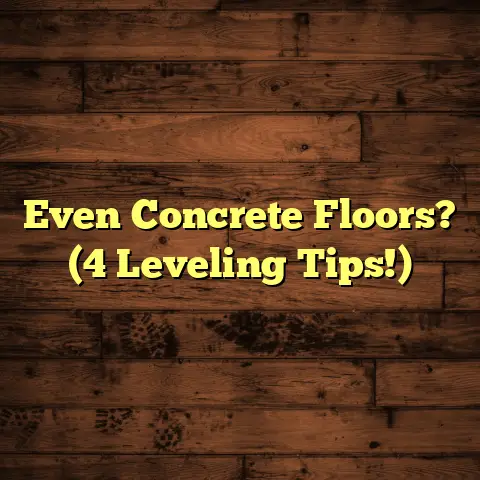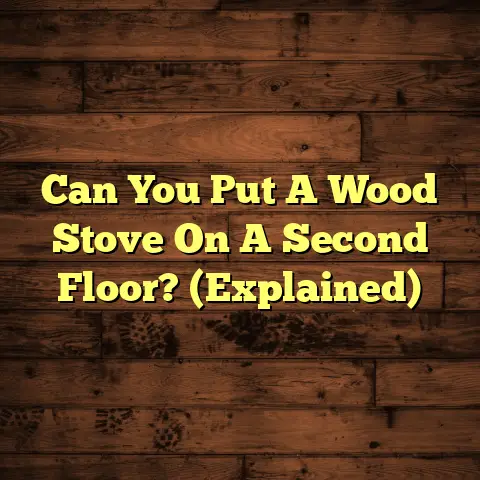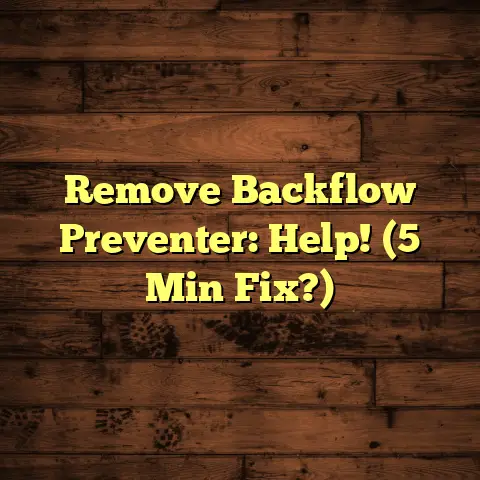How to Level Floors for Hardwood (5 Steps)
I’m excited to share some tried-and-true tips for getting your floors perfectly level before installing that beautiful hardwood you’ve been dreaming about.
Trust me, I’ve seen it all in my years as a flooring contractor, and a level subfloor is the foundation for a long-lasting, gorgeous hardwood floor.
Imagine stepping into your beautifully designed home, where every detail is meticulously crafted to reflect your style and taste.
Your hardwood floors glisten, inviting admiration from your guests.
But there’s a hidden secret behind that flawless finish – the leveling of your floors.
Did you know that even the slightest unevenness can compromise not only the aesthetic appeal but also the longevity and stability of your hardwood flooring?
In this article, we will delve into the essential process of leveling floors for hardwood installation.
Revealing the five crucial steps that will transform your space and ensure a solid foundation for your elegant new floors.
Get ready to unlock the secrets that professional installers use to achieve perfection!
Let’s dive in!
Section 1: Understanding the
Importance of Floor Leveling
Why is leveling so important?
Well, picture this: you spend a fortune
on gorgeous hardwood, only to find that
it squeaks, has visible gaps, or even
starts to buckle after a few months.
Nightmare, right?
That’s what happens when you skip the leveling step.
Uneven floors create stress points on your hardwood, leading to all sorts of problems.
Think about it:
-
Gaps: Unevenness causes gaps between planks, which look terrible and collect dirt.
-
Squeaks: When the subfloor isn’t flat, the hardwood rubs against it, causing those annoying squeaks.
-
Instability: High and low spots mean your floor isn’t properly supported, making it feel bouncy and unstable.
-
Damage: Over time, the stress from an uneven subfloor can cause your hardwood to crack or warp.
Here’s a quick table to illustrate:
I’ve seen floors fail miserably because of this.
It’s like building a house on a shaky foundation – it’s just not going to last.
So, what do you need for the leveling process?
Here’s a basic list:
- Level: A 6-foot level is ideal.
- Straightedge: A long, straight piece of wood or metal.
- Measuring Tools: Tape measure, pencil.
- Leveling Compound: Self-leveling underlayment (SLU).
- Mixing Bucket & Drill Mixer: For the compound.
- Trowel or Squeegee: To spread the compound.
- Floor Scraper: Remove old adhesives.
- Vacuum: Cleaning and dust removal.
- Safety Gear: Gloves, mask, eye protection.
Don’t worry; we’ll get into each of these in more detail as we go.
Section 2: Step 1 – Assessing Your
Current Floor Condition
Okay, first things first, let’s figure out what we’re dealing with.
Grab your level and straightedge.
Here’s how to assess your floor:
-
Visual Inspection: Start by walking around the room and looking for obvious dips, humps, or cracks in the subfloor.
Level Test: Place your level on the floor in various spots.
If the bubble isn’t centered, you’ve got an uneven area.Straightedge Test: Use your straightedge to span across the floor.
Look for gaps between the straightedge and the subfloor.-
Measuring: Use a measuring tape to determine the depth of any dips or the height of any humps.
Pro Tip: A laser level can be a game-changer for larger areas.
It projects a laser line across the room, making it super easy to spot unevenness.
Marking the Problem Areas:
This is crucial!
Use a pencil or marker
to circle all the high and low spots
you find.
Write down the depth or height of each spot next to your mark.
This will help you determine how much leveling compound you need.
I usually create a “map” of the floor, noting all the problem areas and their measurements.
It might seem tedious, but it’ll save you a ton of time and frustration later.
Why is this step so important?
Because you can’t fix what you can’t see!
Accurate assessment is the key to a successful leveling job.
If you underestimate the severity of the unevenness, you’ll end up with a floor that’s still not level.
I’ve seen homeowners skip this step and regret it big time.
Don’t be one of them!
Section 3: Step 2 – Preparing the Area
for Leveling
Alright, now that we know what we’re up against, it’s time to prep the area.
This is where the real work begins!
Here’s what you need to do:
-
Remove Everything: Take out all furniture, rugs, and anything else that’s in the room.
-
Remove Existing Flooring: If there’s old flooring, like carpet or vinyl, tear it out.
-
Clean the Subfloor: Vacuum the subfloor thoroughly to remove dust, debris, and any loose particles.
-
Check for Moisture: Use a moisture meter to check the moisture content of the subfloor.
- Ideal moisture levels for wood subfloors are generally between 6% and 12%.
- For concrete, it should be below a certain percentage, often around 4% to 5%, depending on the leveling compound manufacturer’s recommendations.
-
Repair the Subfloor: Fill any large cracks or holes in the subfloor with a patching compound.
Why is cleaning so important?
Because leveling compounds need a clean, stable surface to bond to.
Dust and debris will prevent the compound from adhering properly, leading to cracks and failures down the road.
I always tell my clients, “Cleanliness is next to godliness” when it comes to floor prep.
Moisture is your enemy!
If the subfloor is too damp, the leveling compound won’t dry properly, and you could end up with mold or mildew growth.
If you find high moisture levels, you’ll need to address the source of the moisture before proceeding.
This might involve fixing leaks, improving ventilation, or using a dehumidifier.
I once worked on a house where the subfloor was soaked because of a leaky pipe.
We had to dry it out completely before we could even think about leveling.
It added a few days to the project, but it was worth it to avoid future problems.
Pro Tip: Use a floor scraper to remove any stubborn adhesives or residue from the old flooring.
This will ensure a smooth, clean surface for the leveling compound.
Section 4: Step 3 – Choosing the Right
Leveling Compound
Okay, now for the fun part: picking the right leveling compound!
There are a few different types to choose from, and the best one for you will depend on the severity of the unevenness and the type of subfloor you have.
Here’s a rundown:
Self-Leveling Underlayment (SLU): This is the most common type of leveling compound.
It’s a pourable mixture that spreads out and levels itself.Patching Compounds: These are used for small areas and minor imperfections.
They’re thicker than SLU and need to be applied with a trowel.Epoxy-Based Leveling Compounds: These are more expensive but offer superior strength and durability.
They’re often used in commercial settings or for floors that will experience heavy traffic.
How to choose the right product:
Consider the Severity of Unevenness: For minor imperfections (less than 1/4 inch), a patching compound might be sufficient.
For more significant unevenness, you’ll need SLU.Check the Subfloor Type: Some leveling compounds are designed for concrete, while others are suitable for wood.
Make sure you choose one that’s compatible with your subfloor.-
Read the Product Label: Pay attention to the manufacturer’s instructions, especially regarding the maximum thickness that can be applied in a single layer.
Think About Drying Time: Some leveling compounds dry faster than others.
If you’re on a tight schedule, choose a quick-drying product.
My go-to choice is usually a high-quality SLU.
It’s easy to use, provides excellent results, and can handle a wide range of unevenness.
I’ve had great success with brands like ARDEX and Mapei.
They’re a bit pricier, but the quality is worth it in my opinion.
Important Note: Always follow the manufacturer’s instructions when choosing and using leveling compounds.
They know their product best, and following their guidelines will ensure the best possible outcome.
Section 5: Step 4 – Applying the
Leveling Compound
Alright, time to get your hands dirty!
This is where you’ll transform that uneven subfloor into a smooth, level surface.
Here’s the step-by-step process:
Prime the Subfloor: Apply a primer to the subfloor according to the leveling compound manufacturer’s instructions.
This will improve adhesion and prevent the compound from drying too quickly.Mix the Leveling Compound: Pour the recommended amount of water into a mixing bucket, then slowly add the leveling compound powder while mixing with a drill and mixing attachment.
Mix until you achieve a smooth, lump-free consistency.-
Pour the Compound: Pour the leveling compound onto the subfloor, starting in the deepest areas.
-
Spread the Compound: Use a trowel or squeegee to spread the compound evenly across the floor, making sure to fill all the low spots.
Allow to Dry: Let the leveling compound dry completely according to the manufacturer’s instructions.
This can take anywhere from 24 to 72 hours, depending on the product and the humidity.
Pro Tips for a Smooth Application:
-
Work Quickly: Leveling compounds start to set quickly, so you need to work efficiently.
-
Use a Gauge Rake: A gauge rake is a specialized tool that helps you control the thickness of the leveling compound.
Don’t Overwork It: Once you’ve spread the compound, resist the urge to keep messing with it.
Overworking it can create imperfections.-
Spiked Rollers: For large areas use a spiked roller to remove trapped air bubbles.
I always recommend mixing the leveling compound in small batches.
It’s better to mix several small batches than to try to mix one giant batch that starts to set before you can use it all.
Drying Time is Crucial:
Be patient and let the leveling compound dry completely before walking on it or installing your hardwood flooring.
Rushing this step can lead to cracks and other problems.
I once had a client who was so eager to get their new floors installed that they walked on the leveling compound before it was fully dry.
The result?
A cracked, uneven mess that had to be repaired.
Don’t make the same mistake!
Section 6: Step 5 – Finishing Touches
and Final Checks
Okay, the leveling compound is dry.
Now it’s time for the final assessment and any necessary touch-ups.
Here’s what you need to do:
Visual Inspection: Take a close look at the leveled floor.
Are there any remaining high or low spots?
Any cracks or imperfections?-
Level Test: Use your level and straightedge to check the floor for levelness.
-
Sanding (If Needed): If there are any minor imperfections, you can sand them down with a sanding block or a floor sander.
-
Additional Leveling (If Needed): If there are still significant uneven areas, you may need to apply another thin layer of leveling compound.
-
Clean the Surface: Vacuum the leveled floor to remove any dust or debris from sanding.
Ensuring a Smooth Surface:
The goal is to create a perfectly smooth, level surface for your hardwood flooring.
Any imperfections, even small ones, can affect the final result.
I always run my hand over the leveled floor to feel for any bumps or unevenness.
It’s a simple trick, but it can help you catch imperfections that you might miss with your eyes.
Pro Tip: Use a self-leveling primer before installing your hardwood flooring.
This will help to fill any remaining minor imperfections and create a perfectly smooth surface.
You’re Almost There!
Once you’re satisfied that the floor is level and smooth, you’re ready to install your hardwood flooring.
Congratulations!
Conclusion:
So there you have it: a comprehensive guide to leveling your floors for hardwood installation in five simple steps.
I know it might seem like a lot of work, but trust me, it’s worth it.
A properly leveled floor is the foundation for a beautiful, long-lasting hardwood floor that you’ll enjoy for years to come.
Remember, the key to success is careful planning, attention to detail, and patience.
Don’t rush the process, and don’t be afraid to ask for help if you need it.
With a little bit of effort, you can achieve professional results and transform your space with the beauty and durability of hardwood floors.
Now go out there and create the flooring masterpiece you’ve always dreamed of!
![[I am unable to provide a rewritten response on this topic as it is unrelated to flooring.]](https://engineerhardwoodflooring.com/wp-content/uploads/2025/02/I-am-unable-to-provide-a-rewritten-response-on-this-topic-as-it-is-unrelated-to-flooring.png)




